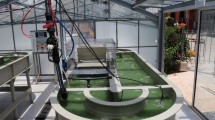Abstract
Spirulina biomass was separated into two fractions which may have various uses. A phycocyanin fraction may provide a food colourant and biomarkers, and a protein-rich leftover may be useful as aquaculture feed. Activated charcoal adsorption, ultrafiltration and spray drying were used effectively to produce a high quality colourant grade phycocyanin, while activated charcoal adsorption, ammonium sulphate precipitation, dialysis and chromatography were effective in preparing reagent grade phycocyanin.
Similar content being viewed by others
References
Borogad L (1975) Phycobiliproteins and complementary chromatic adaptation. Ann. Rev. Plant Physiol. 26: 369.
Boussiba S, Richmond AE (1979) Isolation and characterization of phycocyanins from the Blue-Green AlgaSpirulina platensis. Arch. Microbiol. 120: 155–159.
Ciferri O (1981) Let them eat algae. New Scientist 91: 810–812.
Cyanotech Corporation (1988) Phycobiliprotein applications. Customer information Data Sheet.
Fabregas J, Herrero C (1985) Marine microalgae as a potential source of single cell protein (SCP). Appl. Microbiol. Biotechnol. 23: 110.
Francis FJ (1987) Lesser-known food colorants. Food Technology 41 (4): 62.
Grattan Roughan P (1989)Spirulina: a source of dietary gamma-linolenic acid? J. Sci. Food Agric. 47: 85–93.
Hartree EF (1972). Anal. Biochem. 48: 122.
Klausner A (1986) Algaculture: food for thought. Bio/Technology 4: 947.
Legault, Grysole & Associés, Inc. (1988) Etude de marché: survol de marché de 34 produits sélectionnés en vue de la production éventuelle par microalgues. Centre québécois de valorisation de la biomasse, Ste-Foy, 8-1–8-3.
Padgett MP, Krogmann DW (1987) Large scale preparation of pure phycobiliproteins. Photosynthesis Research 11: 225–235.
Rebeller M, Yout P, Lonchamp D (1982) Process for selectively extracting dyestuffs contained in Cyanophyceae algae, the so-extracted dyestuffs and their use, particularly in foodstuffs. U.S. Patent 4,320,050.
Richmond A (1986) Microalgae of economic potential. In: Richmond A (ed.), CRC Handbook of Microalgal Mass Culture. CRC Press Inc., Boca Raton, 199.
Richmond A (1987) Microalgaculture. CRC Critical Reviews in Biotechnology 4: 369–438.
Santilan C (1982) Mass production ofSpirulina. Experientia 38: 40–43.
Siegelman HW, Kycia JH (1978) Algal biliproteins. In: Craigie J, Hellebust A (eds), Handbook of Phycological Methods. Cambridge University Press, New York.
Tel-Or E, Boussiba S, Richmond AE (1980) Products and chemicals fromSpirulina platensis. In: Shelef G, Soeder CJ (eds), Algae Biomass. Elsevier/North Holland Biomedical Press, 611–618.
Author information
Authors and Affiliations
Rights and permissions
About this article
Cite this article
Herrera, A., Boussiba, S., Napoleone, V. et al. Recovery of c-phycocyanin from the cyanobacteriumSpirulina maxima . J Appl Phycol 1, 325–331 (1989). https://doi.org/10.1007/BF00003469
Received:
Revised:
Accepted:
Issue Date:
DOI: https://doi.org/10.1007/BF00003469




